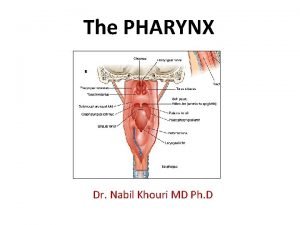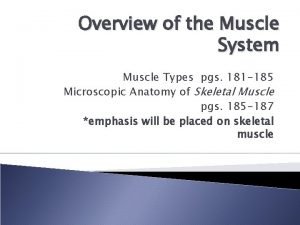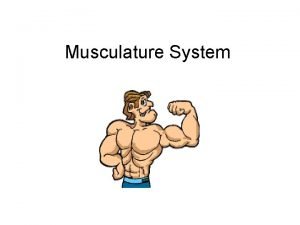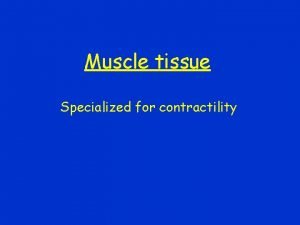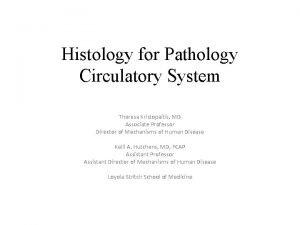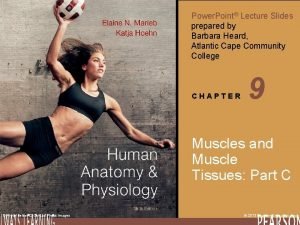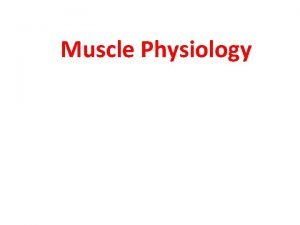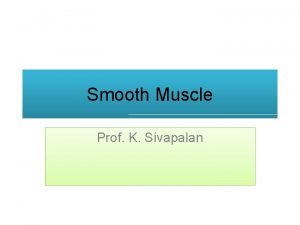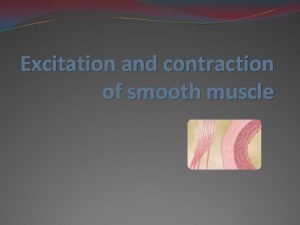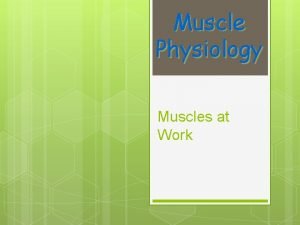Part 3 Smooth Muscles Smooth muscle cells are









- Slides: 9

Part 3: Smooth Muscles

§ Smooth muscle cells are small, spindle shaped cells with one central nucleus, and lack the coarse connective tissue coverings of skeletal muscle. § Smooth muscle cells are usually arranged into sheets of opposing fibers, forming a longitudinal layer and circular layer.

§ Contraction of the opposing layers of muscle leads to a rhythmic form of contraction, called peristalsis, which propels substances through the organs. § Have no striations, no sarcomeres, a lower ratio of thick to thin filaments compared with skeletal muscle.

§ Mechanism and characteristics of contractions § Smooth muscle fibers exhibit slow, synchronized contractions due to electrical gap junctions

§ Like skeletal muscle, actin and myosin interact by the sliding filament mechanism. The final trigger for contraction is a rise in intracellular calcium level, and the process is energized by ATP. § Smooth muscle contracts more slowly and consumes less ATP than skeletal muscle.

§ Regulation of contraction § Autonomic nerve endings release either acetylcholine or norepinephrine, which may result in excitation of certain groups of smooth muscle cells, and inhibition of others. § Hormones and local factors, such as lack of oxygen, histamine, excess carbon dioxide, or low p. H, act as signals for contraction.

§ Special features of smooth muscle contraction § Smooth muscle initially contracts when stretched, but contraction is brief, and then the cells relax to accommodate the stretch. § Smooth muscle stretches more and generates more tension when stretched than skeletal muscle

§ Hyperplasia, an increase in cell number through division, is possible in addition to hypertrophy, an increase in individual cell size.

§ Types of smooth muscle § Single-unit smooth muscle, called visceral muscle, is the most common type of smooth muscle. It contracts rhythmically as a unit, is electrically coupled by gap junctions, and exhibits spontaneous action potentials. § Multiunit smooth muscle is located in large airways to the lungs, large arteries, arrector pili muscles in hair follicles, and the iris of the eye.
 Insidan region jh
Insidan region jh Smooth muscle contraction vs skeletal muscle contraction
Smooth muscle contraction vs skeletal muscle contraction Pharynx skeletal muscle
Pharynx skeletal muscle Comparison of skeletal cardiac and smooth muscle
Comparison of skeletal cardiac and smooth muscle Smooth muscle under the microscope
Smooth muscle under the microscope Nucleus of smooth muscle fiber in cross-section
Nucleus of smooth muscle fiber in cross-section Cardiac skeletal and smooth muscle comparison
Cardiac skeletal and smooth muscle comparison Arterioles vs arteries
Arterioles vs arteries Latch state smooth muscle
Latch state smooth muscle Comparison of skeletal cardiac and smooth muscle
Comparison of skeletal cardiac and smooth muscle


